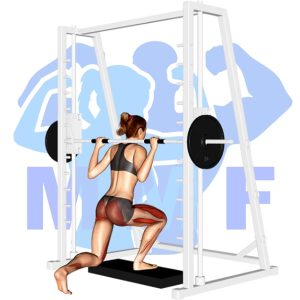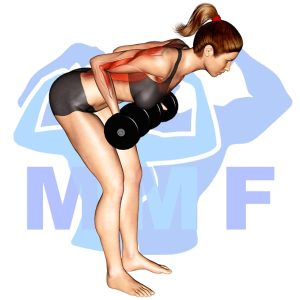Are you looking to add more muscle mass to your upper back and lower body? Do you feel like your regular squats or rows are not enough to make a substantial difference in your physique? Cable squat rows could be the solution to your problem. Many fitness enthusiasts struggle to find exercises that combine lower body and upper back movements effectively. However, with the use of cable machines, you can easily target both muscle groups and achieve that desired toned look. In this post, we will discuss the proper technique necessary for performing cable squat rows and the benefits of integrating them into your regular workout routine. Let’s get started with this powerful exercise that will help you reach your goals!
Cable Squat Row Summary
- Primary Muscles: Deltoid – Posterior
- Secondary Muscles: Adductor Magnus, Brachialis, Brachioradialis, Erector Spinae, Gluteus Maximus, Infraspinatus, Latissimus Dorsi, Pectoralis Major – Sternal, Rhomboids, Soleus, Teres Major, Teres Minor, and Trapezius
- Equipment: Cable Machine with Tricep Rope
- Mechanics Type: Compound
- Force: Push and Pull
- Utility: Basic and Auxiliary

Cable Squat Row Instructions
- Start by setting up a pulley near waist height, with a rope or other two-handed handle.
- Grab the handle with your arms extended and squat.
- Now, stand up while simultaneously rowing by pulling the handle toward you and your elbows behind your back.
- Then, pause briefly at the top, then squat back down while extending your arms back out straight.
- Repeat this compound exercise for 8-12 reps
Video Tutorial
Cable Squat Row Muscles
Target (Agonist)
Synergists
- Adductor Magnus
- Brachialis
- Brachioradialis
- Erector Spinae
- Gluteus Maximus
- Infraspinatus
- Latissimus Dorsi
- Pectoralis Major – Sternal
- Rhomboids
- Soleus
- Teres Major
- Teres Minor
- Trapezius
Dynamic Stabilizers
- Biceps Brachii
- Gastrocnemius
- Hamstrings
- Triceps – Long Head
Stabilizers
- Levator Scapulae
- Trapezius – Upper
- Wrist Extensors
Antagonist Stabilizers

Benefits of Cable Squat Row
The Cable Squat Row is an ideal exercise to include in a strength training or fitness routine as it offers multiple benefits, not least of which is the strengthening of the posterior deltoid muscle. The motion of the exercise requires the user to maintain a bent-over position, with the torso parallel to the ground and the arms extended, while pulling a cable weight towards the body. This combination of movements works to effectively target and strengthen the posterior deltoid muscle, while also engaging other muscles in the upper back and core for additional stability and support. The Cable Squat Row can be a great way to get a full-body workout in a short amount of time and can be adapted to suit any level of fitness or experience.
Tips for Performing Cable Squat Row
Your at the right place if you’re motivated to enhance your cable squat row performance. Using these suggestions will enable you to take full advantage of this amazing exercise. In addition to shaping your upper back and legs muscles, increasing movability, and also a reduced chance of injury can all be accomplished with this exercise. It is time to begin and take a look at how these suggestions will benefit you.
- Maintain Proper Form: Make sure your back is straight and your feet are shoulder width apart. This will ensure you are using the right muscles and avoiding any injury.
- Utilize a Full Range of Motion: Squat all the way down and pull all the way up, this will maximize the effectiveness of the exercise and help build strength.
- Increase Resistance Gradually: Start with a light weight and increase as you become comfortable with the exercise. Doing this will help you avoid injury and allow you to progress safely and efficiently towards your fitness goals.
Benefits and Tips Video
Frequent Mistakes To Avoid
Avoiding common errors can be the difference between a productive training session and a painful injury when executing cable squat row. Additionally, achieving the most out of the exercise requires proper form, and avoiding make any typical errors can help you to perform the exercise better and achieve your desired results. Not only can preventing these mistakes make you more toned, but also can help you feel more assured and inspired when at in the gym. Thus, it is now your turn to maximize your results from this exercise and enjoy the advantages of a successful workout.
- Not using correct posture: Poor posture when performing Cable Squat Row can lead to injury and ineffective exercise.
- Not using the appropriate weight: Using too much or too little weight can lead to ineffective exercise and strain on the body.
- Not monitoring form: Not monitoring form during Cable Squat Row can lead to improper technique and potential injury.
Find More Cable Exercises Here
Variations and Complementary Exercises
Although the Cable Squat Row is a great exercise to incorporate into your routine, it may be beneficial to vary your routine by including other exercises that target similar muscles. Below is a list of variations, complementary, and alternative exercises that can be used to replace or supplement the Cable Squat Row.
Squat

The Squat is a great exercise to complement or substitute for the Cable Squat Row. It is a full body movement that works the quads, hamstrings, glutes, and core muscles, which makes it a perfect exercise to pair with the Cable Squat Row. Additionally, the Squat allows for more freedom of movement than the Cable Squat Row as it can be done with a barbell or dumbbells, allowing for more versatility in the workout. Lastly, the Squat can be made easier or harder depending on the weight used or the range of motion employed, making it a great choice for those looking for a challenging and dynamic exercise.
Smith Machine Rear Lunge

The Smith Machine Rear Lunge is an effective and complementary exercise to the Cable Squat Row. It targets the same muscles in the lower body, but with a different motion. The Smith Machine Rear Lunge works the quads, hamstrings, and glutes by lunging backward from a standing position. Unlike the Cable Squat Row, which requires two cables and emphasizes the back, the Smith Machine Rear Lunge relies on just one machine and focuses on the lower body. This exercise also encourages hip flexion and extension, which helps to strengthen the core and improve balance.
Plyo Split Squats

Plyo Split Squats are an excellent complementary or alternative exercise to the Cable Squat Row. It is a plyometric exercise which requires explosive power and helps to increase the strength and stability of the hips and core. The exercise targets the quads, glutes, and hamstrings, while also activating the upper body by pushing off the ground with the arms. It is an excellent way to add power and explosiveness to any leg workout routine, making it a great alternative to the Cable Squat Row.
Check Out These Top Cable Exercises
Inverted Row

The Inverted Row is a great complementary or alternative exercise to the Cable Squat Row. It is a bodyweight exercise that involves using a bar to pull your body up to the bar, while keeping your body in a straight line. This exercise works your back and core muscles, and can be done in a variety of ways. It is an excellent way to target the back muscles and can also be used as a form of active recovery after a hard workout. The Inverted Row can be done with a barbell, kettlebell, or TRX suspension trainer, making it an ideal exercise for people with limited equipment. This exercise is an excellent addition to any workout routine as it allows you to work on both strength and stability.
Reverse Grip Bent Over Dumbbell Row

The Reverse Grip Bent Over Dumbbell Row is a great complementary or alternative exercise to the Cable Squat Row. This exercise is an excellent way to strengthen your back muscles while also targeting your biceps, lats, and shoulders. To perform this exercise, you need to start with a dumbbell in each hand and bend your knees slightly. Then, keep your back straight and lower your torso until it is almost parallel to the ground. From this position, use your back muscles to lift the dumbbells up towards your chest, squeezing your shoulder blades together at the top of the movement. This exercise can also be performed on a bench, which allows for increased stability and control.
Bent Over Rotating Dumbbell Row

The Bent Over Rotating Dumbbell Row is a great alternative or complementary exercise to the Cable Squat Row. It targets the same muscle group as the Cable Squat Row, but with a different angle. This exercise is performed by bending over at the waist and holding a dumbbell in each hand. The arms are then extended outward, and the elbows are bent back towards the body. As the elbows are pulled back, the shoulder blades should be retracted and squeezed together. This exercise helps to strengthen and sculpt the back muscles, shoulders, and arms.
Find More Back Exercises Here
Opposing Complementary Exercises
It’s important to complement your Cable Squat Row routine with exercises that target opposing muscle groups. This will help you achieve a balanced, full-body workout. To further enhance your routine, here are a few exercises that work the opposite muscles as Cable Squat Row.
Curtsey Lunge

The Curtsey Lunge is an excellent exercise to pair with the Cable Squat Row. This exercise works the opposing muscle groups, meaning it focuses on strengthening the muscles in the opposite direction of the Cable Squat Row. The Curtsey Lunge targets the glutes, quads, and adductors while the Cable Squat Row focuses on the back, biceps, and core. Both exercises build strength and stability, allowing you to build a strong, balanced body. By pairing these two exercises together, you can get the best of both worlds and maximize your results.
Stationary Lunges

Stationary lunges are a great complementary exercise to cable squats and rows. They work the opposing muscle group to the cable squats and rows, targeting the quads and glutes while cable squats and rows focus on the hamstrings and back muscles. This helps to create a balanced lower body workout, as well as strengthen stabilizing muscles around the knee joint. Lunges are especially beneficial for athletes looking to improve their balance, agility, and stability. Lunges can be done with a barbell, dumbbells, or bodyweight for added resistance. Doing stationary lunges after cable squats and rows will help create more muscular symmetry and help with overall performance.
Smith Machine Single Leg Deadlift

The Smith Machine Single Leg Deadlift is a great complementary exercise to the Cable Squat Row, as it works the opposing muscle group. It helps to strengthen the lower body and improve balance by focusing on single leg movements. Additionally, it strengthens the glutes and hamstrings while also increasing core stability. This exercise is a great addition to any lower body workout routine and will help to maximize the gains achieved from the Cable Squat Row.
Squat, Row, Repeat: A Full-Body Workout!
Squat, row, repeat – a full-body workout that targets multiple muscle groups simultaneously. This efficient and effective workout involves using resistance cables to perform squats and rows. Squats work your lower body, including your glutes, quads, and hamstrings, while rows target your back muscles and biceps. By combining these two exercises, you can get a comprehensive full-body workout in just a few moves. Plus, using resistance cables allows you to customize the resistance level to your fitness level, making it a great workout for beginners and advanced athletes alike.
References: Wikipedia | ExRx.net | PubMed.gov | Comprehensive List of Back Cable Exercises

